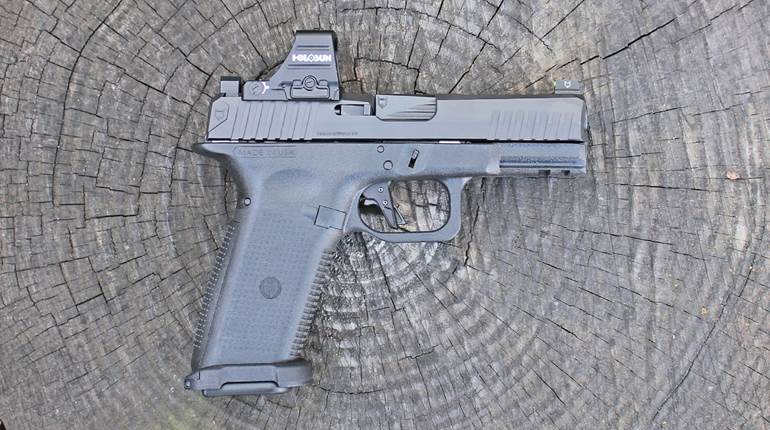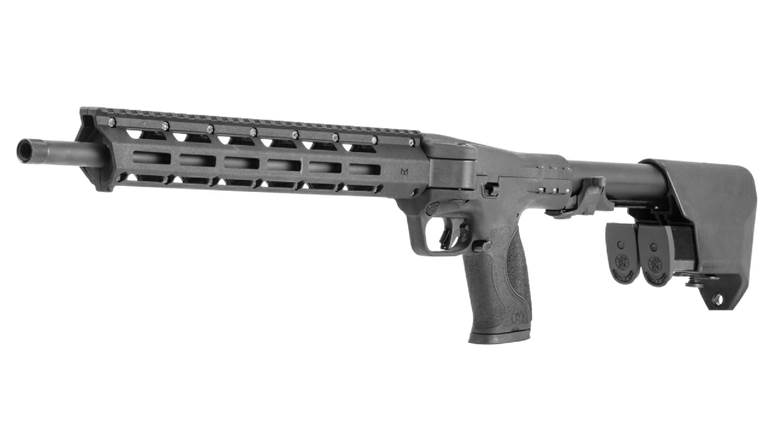
12/5/2012
Last year, Charter Arms released the first in its line of rimless cartridge Pitbull revolvers chambered in .40 S&W. Although it was not the first revolver designed to chamber semi-auto cartridges without the use of moon clips, it was the first in this relatively new .40-caliber cartridge. The choice to launch the Pitbull line in .40 S&W left some scratching our heads. Out of the three most popular semi-auto defensive calibers in the U.S., including the potent .45 ACP and affordable 9 mm, .40 S&W seemed the least logical option to be the first out of the gate. Nick Ecker, President of Charter Arms, said the goal was to serve the needs of the law enforcement community first, and then follow up with 9 mm and .45 ACP versions in the future. And as promised, the 9 mm is now coming off of the assembly line.
The new 9 mm Pitbull shares a good deal in common with its .40 S&W sibling. It is a double-action revolver constructed from stainless steel with a fixed sight system and a hand-filling neoprene grip. The exposed hammer allows the Pitbull to be fired in single-action or double-action mode. The key design difference of the Pitbull line from other Charter revolvers is in the ejector star. It contains a spring-loaded plunger for each chamber. These little plungers move toward the center of the ejector star as a round is loaded, and then snap back out to set into the groove along the rimless cartridge base. With the 9 mm cartridges head spaced from the cartridge mouth, and the plungers in place, the loaded rounds stay in place until ejected by the shooter. The plungers eliminate the need for the use of half-moon or full-moon clips, which are usually required to eject semi-auto cartridges from a revolver.
Like the .40 S&W version, the 9 mm Pitbull proved to be handy and comfortable to work with on the firing line. Shooting standard pressure loads produced felt recoil levels in the mild to moderate range for a medium bore revolver. The stoutest loads did not exceed the level of recoil produced by a lightweight J-frame loaded with .38 Spl. +P. The hand-filling neoprene grip worked to further mitigate felt recoil. Although the trigger felt a little stiff at the start of testing, with some stacking about half way through the trigger stroke, it smoothed out by the end of the first 200 rounds fired.
Some readers may to be quick to notice the absence of +P defense loads in the accuracy results for this revolver. According to Charter Arms President Nick Ecker long-barreled revolvers and full-size semi-autos show increased velocity using +P ammunition, but short-barrel revolvers do not gain the same benefit. The reduced barrel length does not provide enough time for the +P powder loads to burn completely. As a result +P ammunition generates an increased level of muzzle flash and muzzle rise that is not beneficial to down-range accuracy.
But muzzle flash and recoil aside, some Pitbull owners are still going to think about shooting +P ammunition. The short answer to the burning safety question is yes, +P loads can be safely fired in the Pitbull. However, Charter Arms recommends, for the best accuracy results and reduced wear and tear to the gun, that Pitbull owners stick with standard pressure 9 mm loads for both practice and self-defense. This is Charter's stand on the subject, so accuracy testing was conducted with standard pressure loads.
As part of the range testing for this unusual revolver, the rimless-cartridge Pitbull was tried with four different methods of loading, not all of which are available with rimmed revolver cartridges. First was simply pressing loose cartridges from a box into the cylinder one by one. This requires a little added pressure to overcome the plungers, but only just enough to be noticed.
If you tip a standard revolver with the cylinder open, the rimmed cartridges will drop out onto the floor. But with the Pitbull, each single round locked into place and stayed put, even when the cylinder was turned completely upside down and given a vigorous shake. This is a very positive ammunition retention feature, especially if someone has to reload the cylinder and press it back into the frame while under duress, with cold hands or wet fingers.
Up next was the HKS 547 speed loader, which produced an unexpected result. Originally designed for a short-lived Smith & Wesson revolver released in the 1980s, this now discontinued speed loader is still available if you shop around. While this six-round speed loader is just the right diameter to fit the Pitbull cylinder, and the cartridges line up properly, the plungers block the cartridges from dropping into place. This means that after the speed loader is released and dropped away, the 9 mm cartridges are left sticking up from the cylinder. Each round then has to be pressed into place and has the potential of falling out in the process. Although the HKS speed loaders will continue to be one of my favorite products to use with rimmed-cartridge revolvers, the model 547 is not a useful reloading option for the Pitbull.
For those looking to carry the Pitbull with a compact reloading device, the Tuff Product 9 mm Quick Strips were a good fit. These flat rubber strips hold six rounds of ammunition and allow two rounds to be loaded at a time. With a little practice they're easy to use, and certainly a good fit for carry in a pants or purse pocket.
Last, but not least, the Pitbull was loaded using a 9 mm double-stack magazine. Why practice loading a revolver with a magazine? There are a few good reasons to give it a try. For an officer carrying a semi-auto as a duty gun, and the Pitbull as a backup, being able to reload from a spare magazine would eliminate the need for secondary ammo carriers like a speed loader or Quick Strips. This is also true for families in which one spouse prefers a 9 mm semi-auto while the other reaches for a revolver. A couple of pre-loaded spare magazines will feed either gun in a pinch. Once I got the hang of it, reloading the Pitbull from a magazine proved to be the fastest of the four methods tested.
During the ammunition and function testing, I discovered what may be a unique kind of ammunition sensitivity. All of the rounds fired and ejected flawlessly, but one load in particular would not fit in the revolver. Hornady’s 135-grain Critical Duty, which has functioned perfectly for me in semi-auto pistols, seated in the cylinder, but the cartridge rims were just a little bit thicker at the base than the other test loads. As a result, it was very difficult to close the cylinder and impossible to cycle the cylinder by pulling the trigger.
This level of tightness of the rim against the frame could have been due to the nickel coating on the brass cases, or a brass lot with slightly thicker rims. Other Hornady cartridges worked splendidly. The moral of the story is this: Just as it's necessary to test 9 mm for proper function in a semi-auto, you will need to do the same with the Pitbull revolver. Don’t buy a bulk box of a particular round until you’ve taken it for a spin.
So where exactly does the Charter Pitbull rimless-cartridge 9 mm fit into the average defense plan? A rugged, simple, stainless-steel snubbie revolver that is affordable makes a great concealed-carry or home-defense gun. The 9 mm chambering, when fired with standard pressure loads, keeps it both comfortable and affordable for practice, and successful elimination of the need for moon clips makes loading and reloading the Pitbull as convenient as any other defensive revolver. For law enforcement officers, it's a sensible back-up gun. For those who already own and shoot 9 mm semi-autos, the Pitbull can be added to your shooting set without the addition of another caliber of ammunition to stock up on.
Manufacturer: Charter Arms; Charterfirearms.com
Model: Pitbull
Action: Double-Action Revolver
Caliber: 9 mm
Finish: Matte Stainless Steel
Grip: Black Neoprene
Sights: Fixed
Barrel Length: 2.3”
Overall Length: 6.5”
Height: 5”
Width: 1.44”
Weight: 20 ozs.
Capacity: 6 Rounds
Twist: 1:10" RH
Rifle Grooves: 6
Suggested Retail Price: $465





































